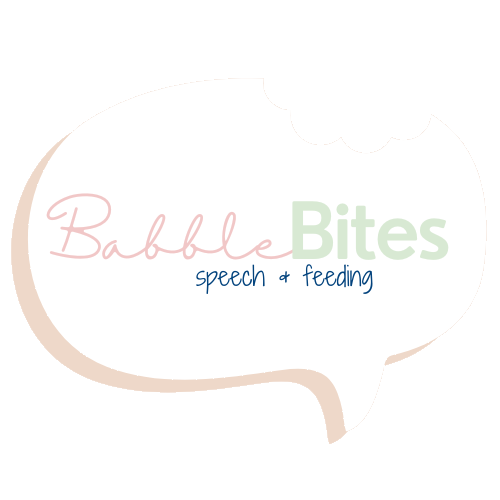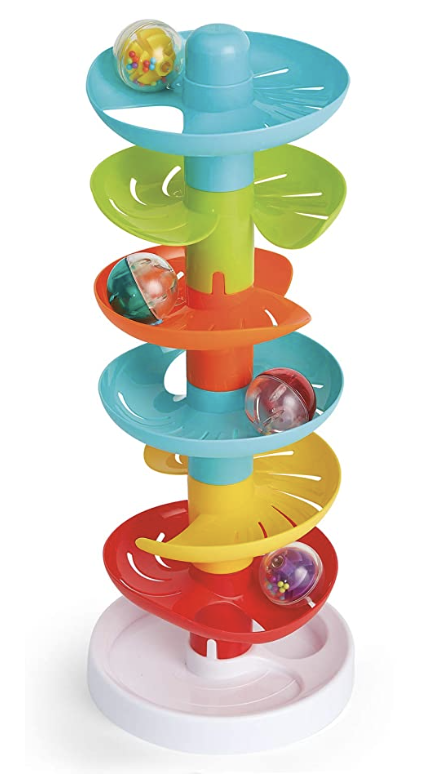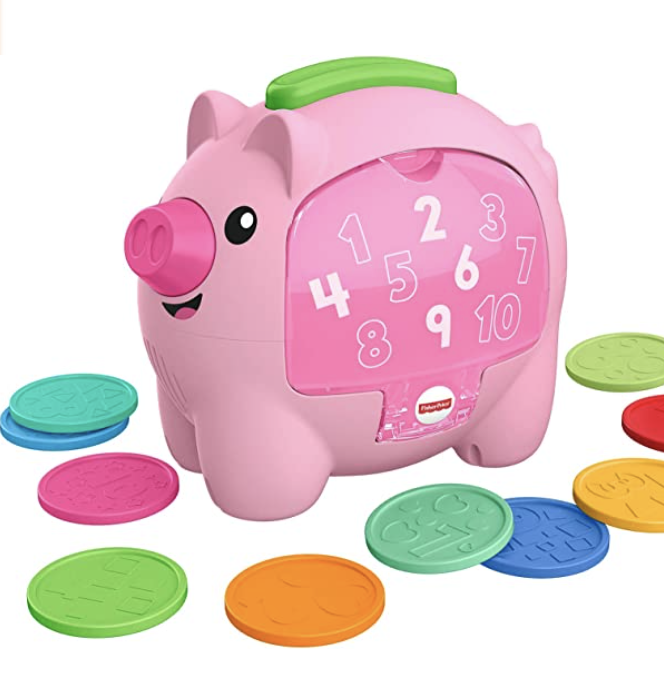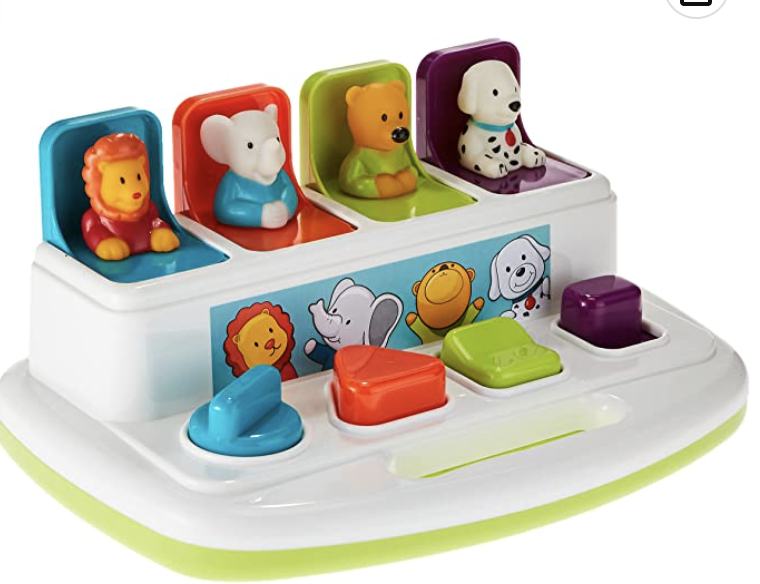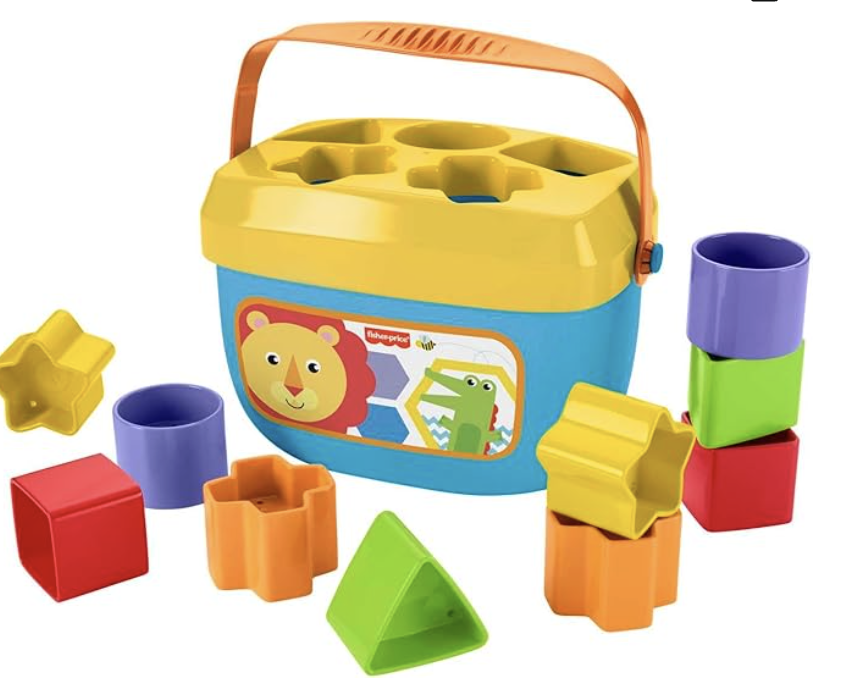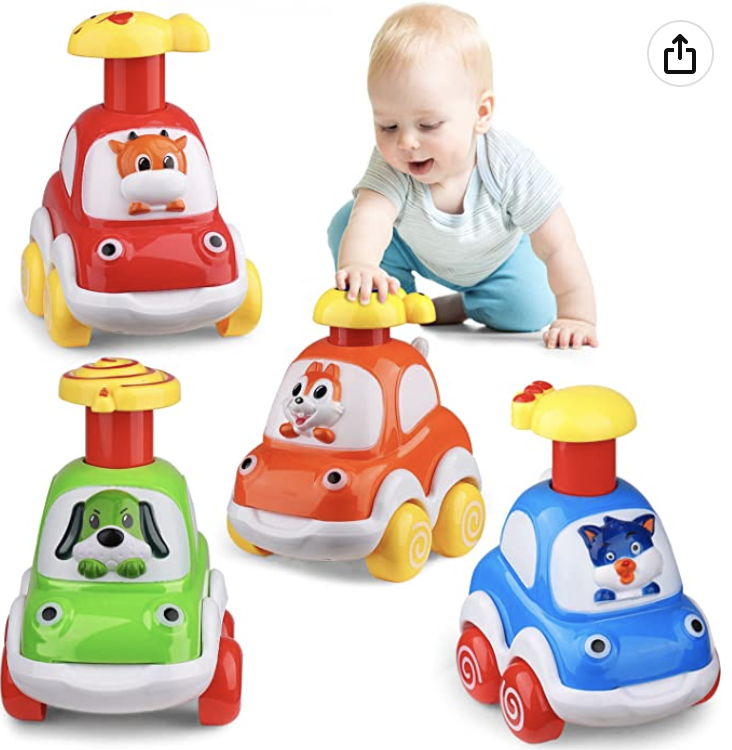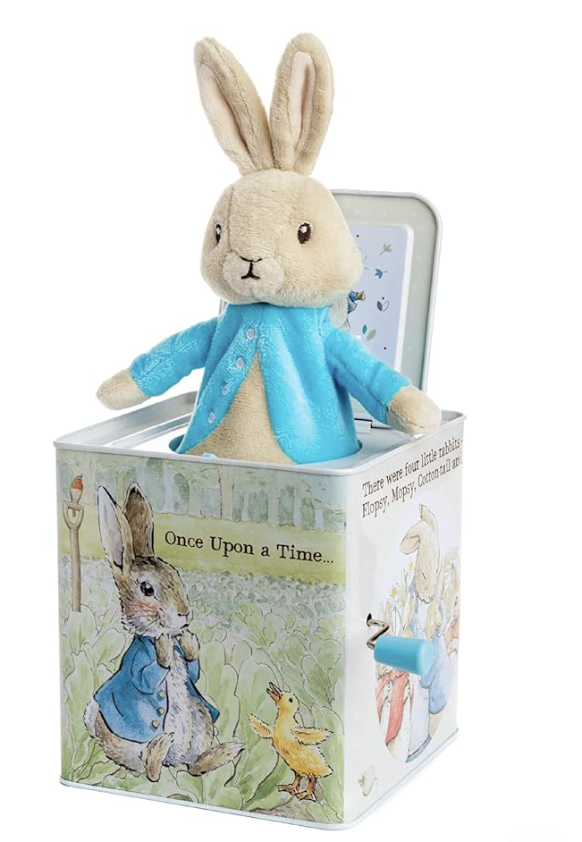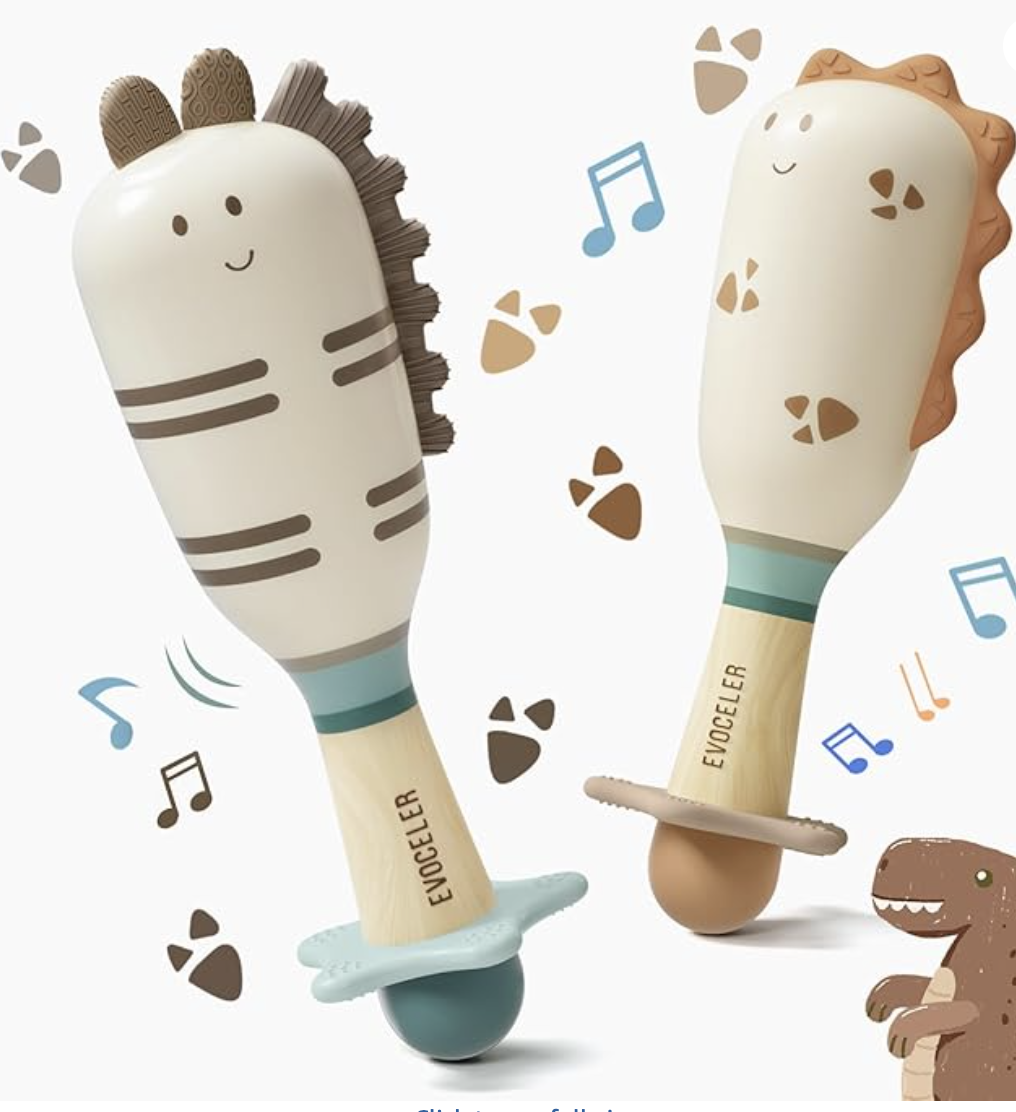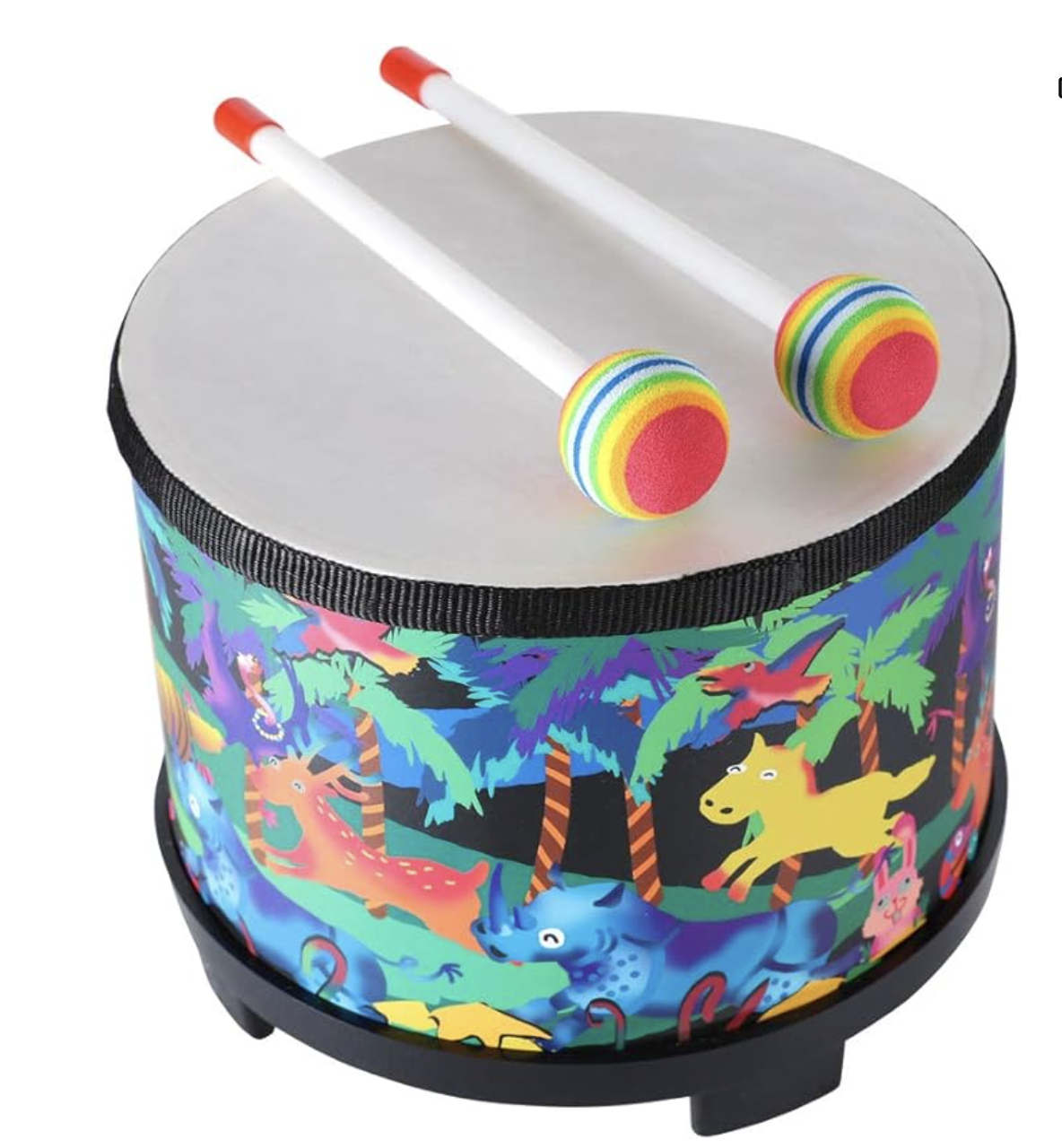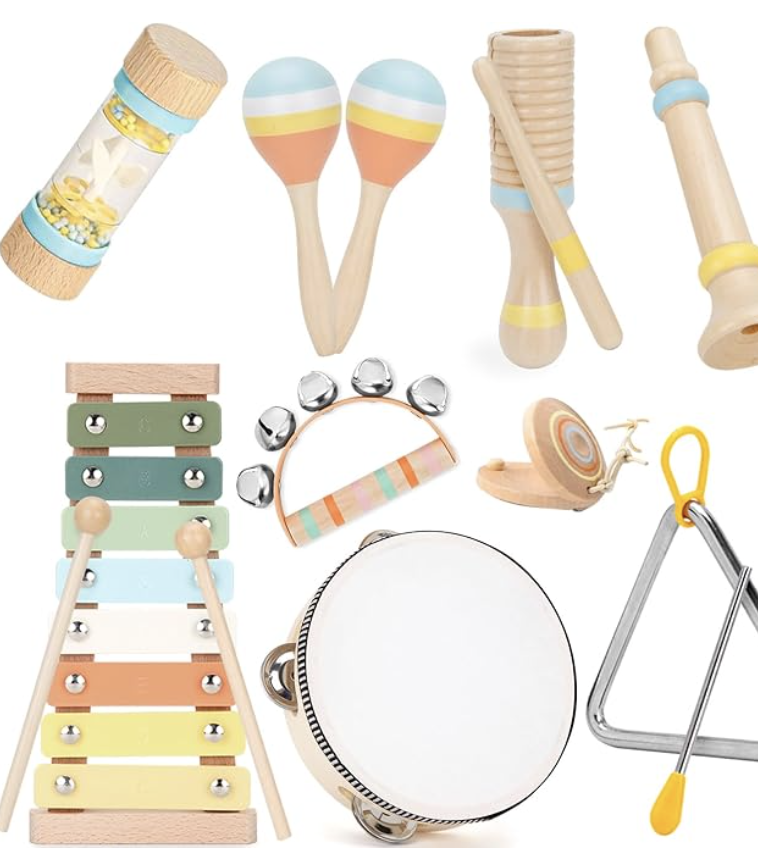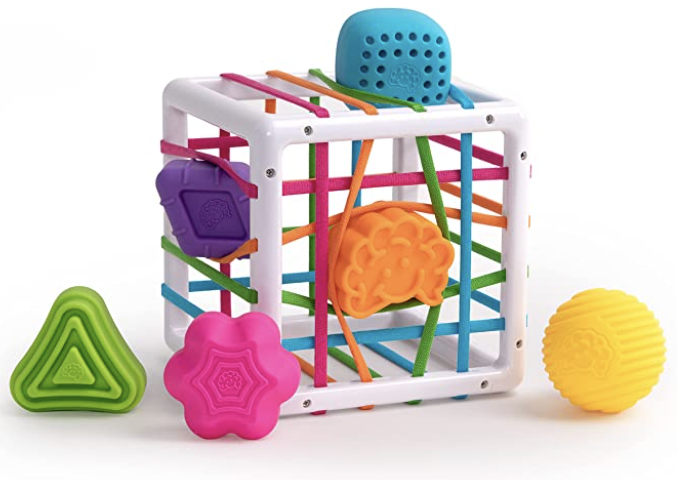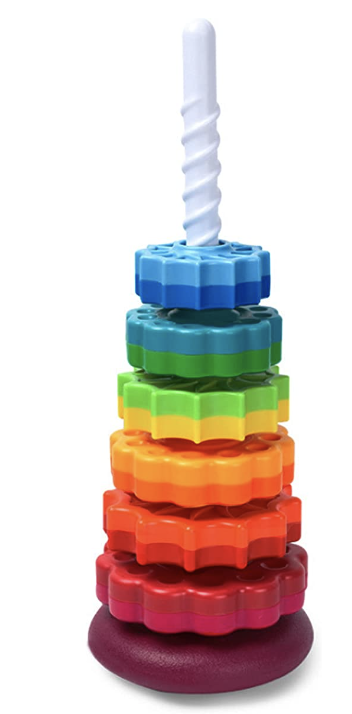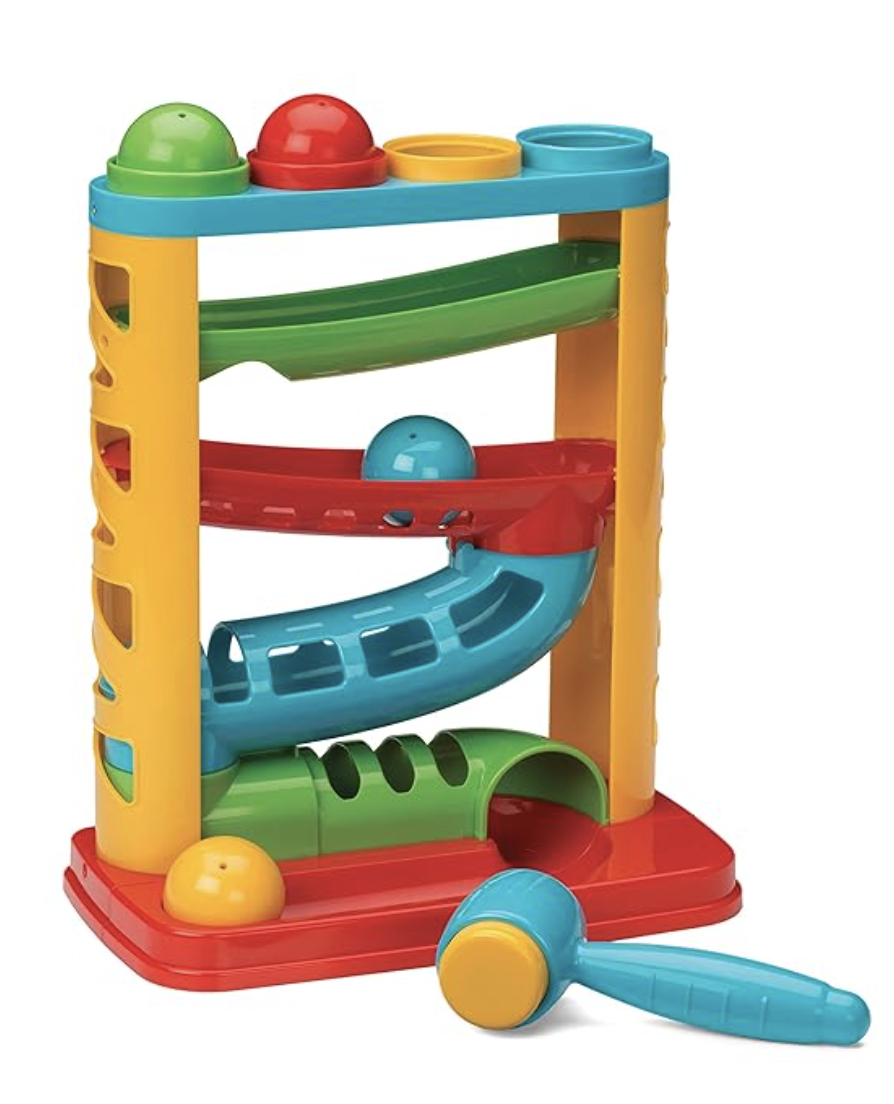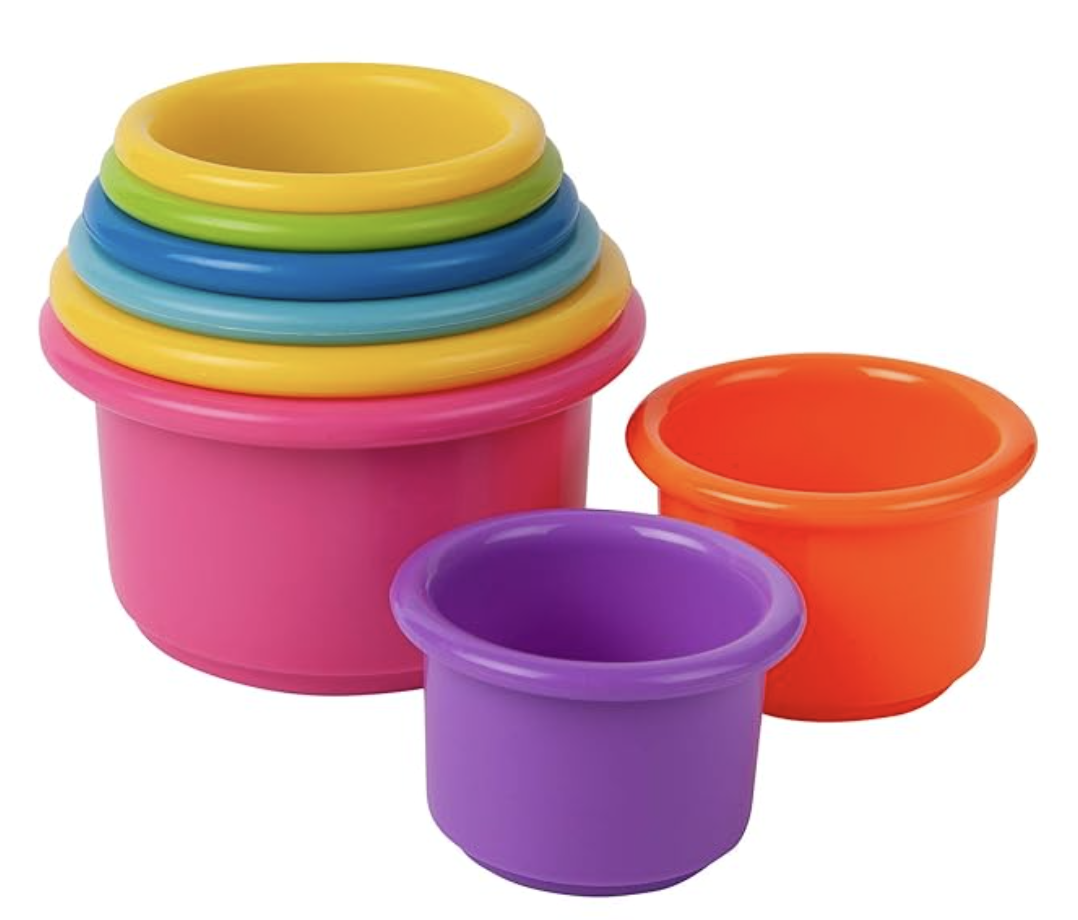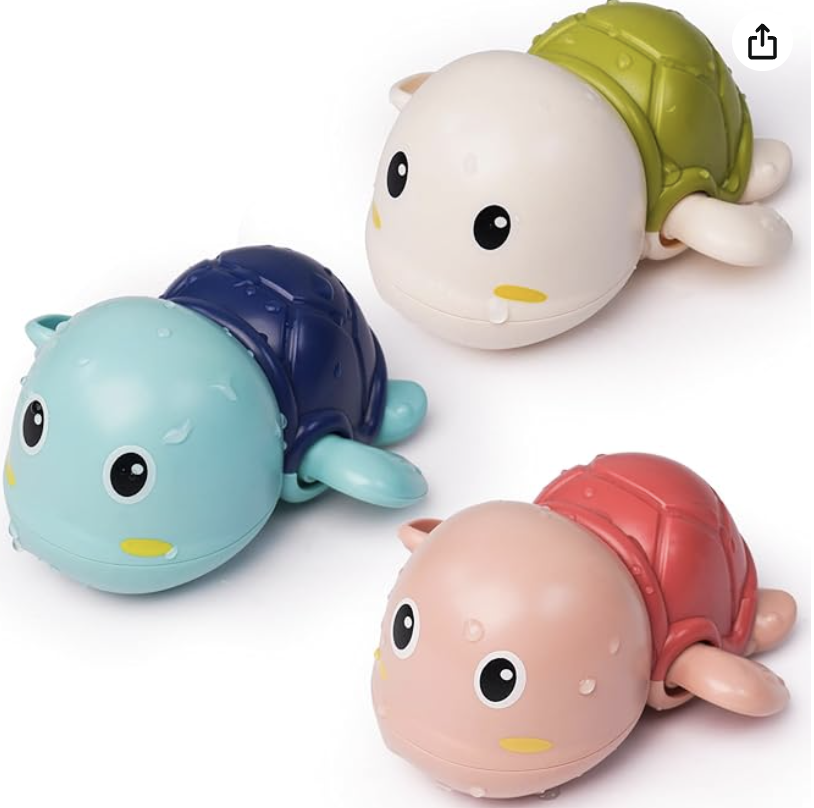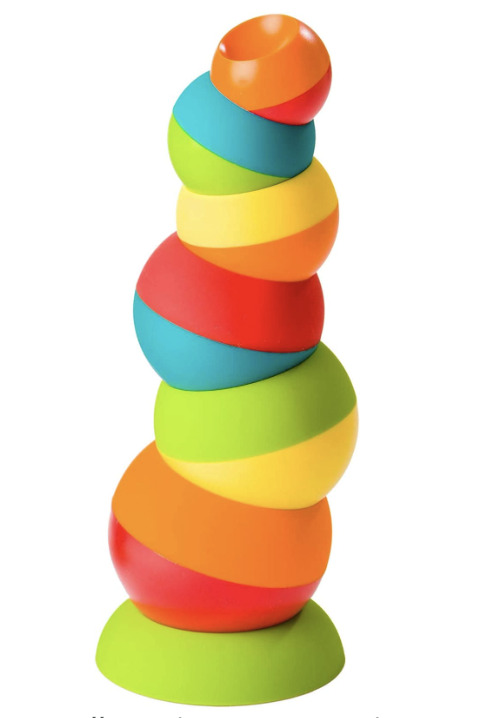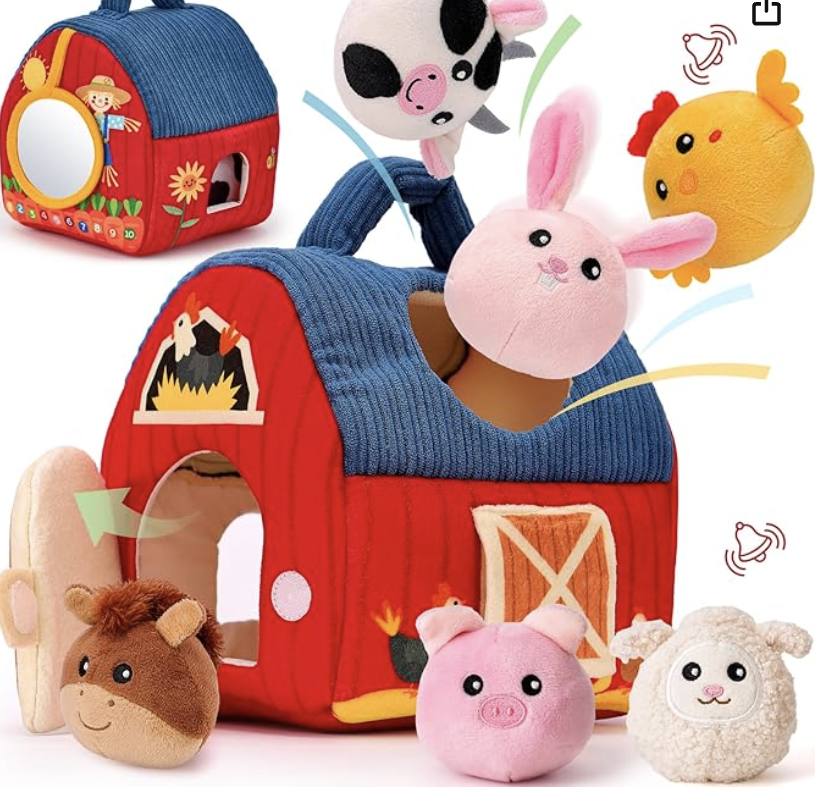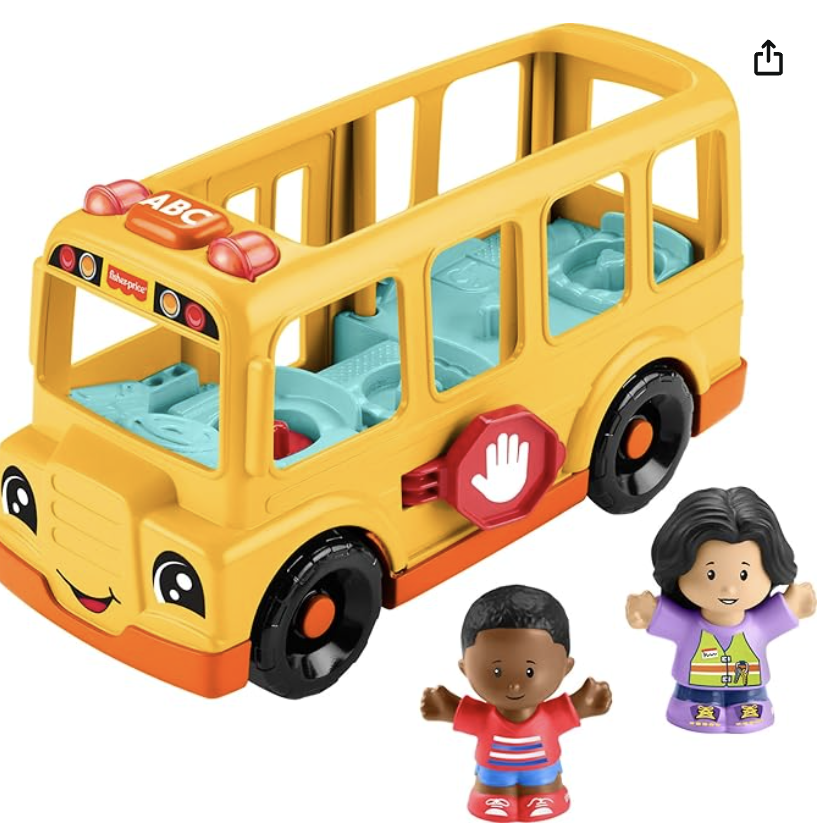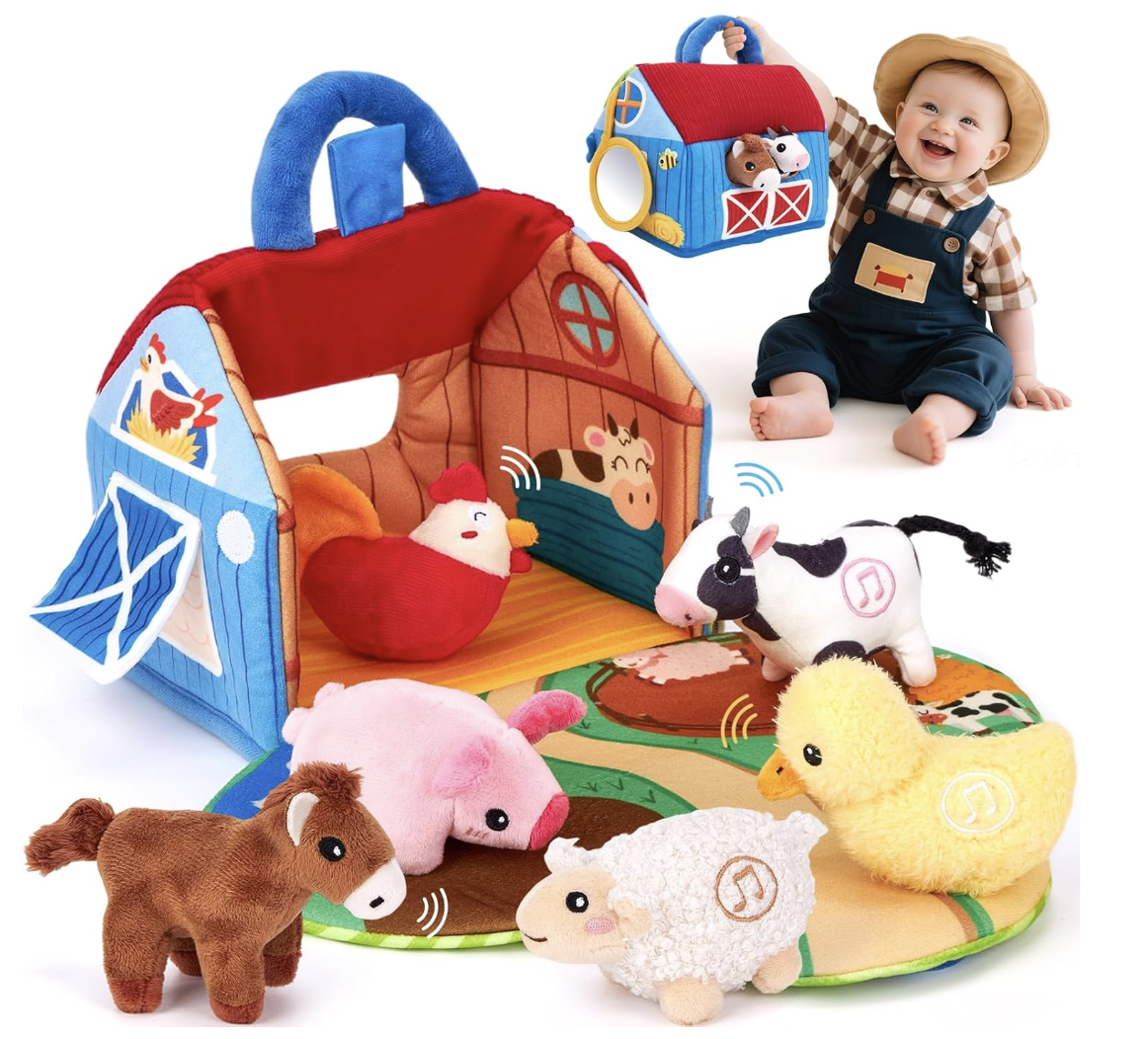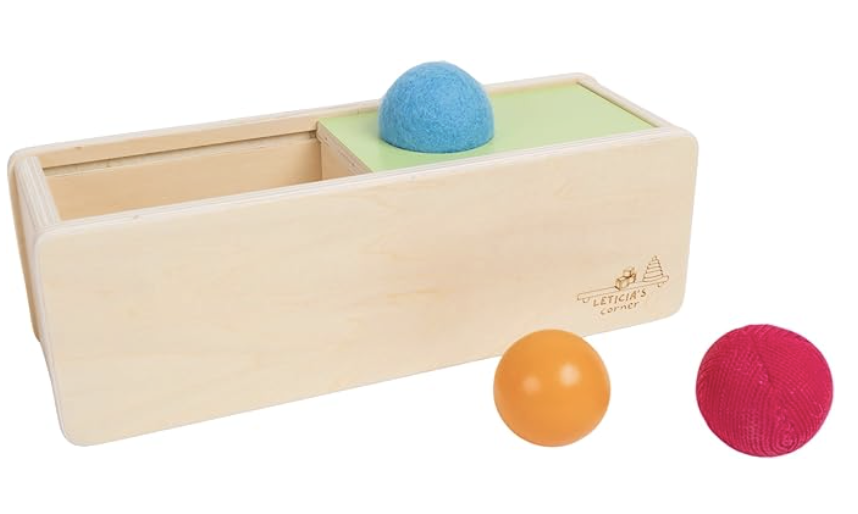Baby Toy Guide
9-18 month olds
Are you looking for the perfect Christmas or holiday present for a 9-18 month old or a birthday present for a 1 year old that can actually help develop important prelinguistic and early language skills? Look no further! Starting around 6-9 months of age, your child can start interacting with “more advanced” toys compared to toys from their “infant days.” Your baby is starting to learn cause and effect, and benefits from toys that teach them that their actions result in specific outcomes. Your baby is also developing object permanence, meaning they know an object still exists, even when they can’t see it anymore. Babies at this age are in the sensorimotor stage according to Piaget’s theory of development, meaning they learn by focusing on what they see and do. They are doing many “experiments” throughout their day, to learn how the objects in the world around them interact. At this age, children typically engage in solitary play, meaning they are not yet fully interested in the play and objectives of others, but you can still model how toys work, and engage in simple play routines together, while embedding meaningful language. Toys that are best for this age focus on cause-and-effect, developing object permanence, and sensorimotor play skills.
Is your child getting closer to 18 months? Check out my Toddler Toy Guide for 18 months to 3 year olds!
As an Amazon Associate, we earn from qualifying purchases. This means that at no additional cost to you, if you make a purchase through certain links on this site or any related social media platforms, we may make a small commission. We only feature products that we believe in and use ourselves. Your support means the world to us and allows us to host this website. Thank you!
Below is a list of my favorite toys, as a pediatric speech-language pathologist, and toddler mom, for 9-18 month olds, and how you can use them to advance their early language skills!
Ball Ramp
Ball ramps are a super fun and easy cause and effect toy. This ball ramp was one of my daughter’s absolute favorites at this age! Embed verbal routines, such as, “Ready, set, go,” “up up up,” “ball on,” and “roll down.” By repeating these phrases every time you play with this toy, you’re setting your child up for success to say these words during play with this toy in the future! You can eventually incorporate the cloze statement strategy, as well, by modeling “Ready, set…” and pausing to see if your baby tries to fill in “go!” even if it’s just a vocalization! In addition to this, “Ball” is a common early word, so you can also have your baby practice requesting, “ball,” if they are starting to use some words! Hold the balls and look at your child expectantly (smiling, eyebrows raised, mouth open, as if you’re waiting for them to say something), if your baby doesn’t independently say '“ball,” model the word for them, “ball,” while holding the ball up near your mouth to draw their attention to the way your mouth is moving, and wait 3-5 seconds to see if they request it! Avoid saying, “say ball,” and simply model what you want them to say (“ball”) instead. This is also a great toy for your baby to practice saying or signing, “more!”
Coin Slot Toy
Coin slot toys are great for fine motor skills, as well as developing object permanence. Model verbal routines including, “put in,” “push push push,” “blue/yellow in,” “open door.” You can also work on your baby signing “more,” or if your baby is starting to use some words, you can practice having them request “more” verbally.
*Tip: As a speech-language pathologist, I prefer to keep most toys that make electronic sounds turned off, or take out the batteries. This lets your baby focus on the words you are saying, rather than getting distracted by the rapidly changing sounds produced by the toy. Typically children repeatedly press buttons, and do not functionally engage with the auditory “directions” given by these toys.
Piggy Bank Coin Slot
Wooden Coins and Slot
Pop-Up Animals
This is a classic cause-and-effect toy. Your baby can work on fine motor skills learning to push and activate all of the different buttons. Work on animal sounds by modeling the animal sound each time one of the doors pops open!
Shape Sorters
This is a classic toy that helps develop your baby’s fine motor skills, early problem solving skills, and object permanence. If your child is struggling to get the shapes in, you can cover some or all of the holes with your hand, to help guide your baby to the correct one. You can eventually fade this out, and use pointing as a lesser support. Use verbal routines, such as, “put in,” “push push push,” and “all done.” This toy also creates opportunities for your baby to request with functional words like “help” or “more!”
Push/Pull and Go Cars
Push and go cars are a fun way to work on cause-and-effect, and the “ready, set, go” verbal routine! Push the button down while you say, “ready, set…” and when you release it say, “go!” Work on early turn taking skills, by taking turns with your baby. You can incorporate other verbal routines such as, “go car,” and “car fast!”
Top Button Push and Go Cars
Plush Pull and Go Cars
Jack-In-The-Box
Jack-in -the-boxes are great for helping to develop object permanence as your baby practiced pushing the animal inside the box, as well as the prelinguistic skill of anticipation, as they anticipate the animal popping back out! You can work on functional words like “open” and “close,” action words like “hiding” and “turning",” prepositions like “in” and “out,” and words with early developing sounds like “pop!” Your baby will likely need some help turning the lever before they learn how to do it by themselves, so it gives them great opportunities to practice saying or signing, “help!” These come in many different character options, too!
Mirror
Mirrors are great for working on imitation and sound play with your baby. Sit in front of the mirror with baby and practice making sounds together. Focus on early developing sounds, and see if your baby starts to imitate you. For example, try “mamamama, babababa, nunununu.” Baby’s will produce reduplicated babbling, or the same sound repeated first, so this is a good place to start. Point to your mouth, and your baby’s mouth to encourage the imitation. Using the mirror lets baby see your face and their own face at the same time, which can help encourage imitation. You can get a baby mirror, or a long mirror you lay horizontally on the floor if you want something bigger.
Baby Instruments
Baby instruments, including xylophones, drums, maracas, and pianos, are all great for this age. They help teach and encourage gross motor imitation (i.e. imitating actions), which precedes and is a foundational skill for sound and speech imitation. See if your little one imitates you shaking the maracas, tapping the sticks on the xylophone, or banging on the drum with your hands. Instruments can also be used while singing favorite songs. Use the instrument while singing, and pause before saying the last word of a phrase, or before starting the next verse (check out cloze statements to see how this works). Your little one may be too young to fill in the missing word, but see if they vocalize or play the instrument (e.g. bang the drum or shake the maraca) to indicate they want you to keep going, and they know something is missing!
InnyBin
The InnyBin encourages development of fine motor skills, as your baby has to push the fun shapes through the elastic bands, and it becomes more challenging depending on which side of the cube your baby is pushing the shapes through, keeping it interesting. While your child plays with this toy, it provides a lot of language opportunities. You can model fun sound effects (e.g. oof, errrg, wow, woah, boop, pop) as your child pushes, or attempts to push, each shape through. Babies often imitate sound effects before imitating words, so this provides some fun opportunities to make some silly sounds that your baby might start to eventually imitate! You can also label action words while you and your baby interact with this toy, such as push, flip, turn, try, spin, help, and pull. Of course you can also start to label colors and shapes, but your child will have plenty of time to learn “academic words,” so focus on functional words (words that help them communicate and get their needs met) first.
Spinning Ring Stacker
Spinning stackers are a fun take on the classic ring stacker. Playing with this toy provides opportunities for using the “ready, set… go!” verbal routine, by holding the shape at the top of the stake while you say, “ready, set…” before letting in spin down on “go!” You can eventually use the cloze-statement strategy by pausing before saying “go,” and wait for your child to either make eye contact with you, vocalize, or maybe even say “go” to indicate they know a word is missing, and they communicate with you (verbally or non-verbally) that they want you to let the ring go! You can also model other verbal routines, such as, “spin down,” “put on,” and “take off,” as well as introduce early size concepts “big” and “small.”
Ball and Hammer Toy
Ball and hammer toys work on fine and gross motor skills (placing the balls in the holes, banging the balls with the hammer), as well as cause and effect. Model sound effects such as, “boom boom boom,” and action words like hit, put, roll, go, look, and drop. You can also start working on simple directions. Give pointing cues to help your little one understand the direction. For example, say, “Put the ball in the hole,” while pointing to the ball while you say “ball” and the hole when you say “hole.” After you’ve given this direction many times, you can try giving the direction without pointing. You can try other directions like, “Give me the hammer,” “Give me a ball,” and “Hit the ball,” using pointing visual cues as needed. You can also work on early matching skills by matching up the ball color with the matching hole.
Blocks
Blocks are a foundational toy that have so many benefits. They help work on fine motor, visual, and spatial reasoning skills. Play with blocks also provides many language opportunities. Due to the repetitive natural of stacking blocks, you can repeatedly say the same word over and over again, in context. This helps solidify your baby’s understanding of the word, as children need to hear words many times before they understand the meaning, and they will not use the word functionally to communicate until they understand what the word means. Try saying “up” or “on” each time you and/or your little one puts a block on the tower. You can also embed verbal routines as you stack the blocks , such as, “put on,” and “kaboom” or “fall down!”
6+ months
12+ months
Bath Toys
Bath time is a great daily routine to incorporate meaningful language. In addition to the verbal routines you can be modeling at each bath time, adding in bath toys provides additional fun language opportunities! Suction cup pipes can be used to stick on the wall while you model words and phrases like, “stick on,” "pour,” “down,” “spin,” “more water,” and “whoosh!” Animals can be used to practice saying animal sounds, as babies often imitate environmental sounds (e.g. animal sounds, vehicle sounds, sound effects) before they imitate true words. Waterproof wind up toys are fun to play, “ready, set… go!” in the water, and model verbs like “swim.”
Tobbles
Like blocks, Tobbles provide opportunities for repetitive actions and therefore repetitive language. This helps solidify your baby’s understanding of words, as children need to hear words many times before they understand the meaning, and they will not use the word functionally to communicate until they understand what the word means. You can repeatedly say the same word over and over again, in context. Try saying “up” or “on” each time you and/or your little one stacks a Tobble. You can also practice saying, “Woah,” and “uhoh!” as the tower wobbles.
Plush Animal Houses
Animals and their houses provide opportunities to work on animal sounds. Imitating animal sounds is typically a precursor to imitating words, so this is an important skill to help work on imitation skills. Some sets make the animal sound when you squeeze the animal, too. You can use farm animals to accompany your singing of “Old McDonald.” Hold two choices up to let your little one choose while animal they want you to sing next. For example, “And on that farm he had a….horse or sheep?” Slightly shake each animal and look at it while you say its name. This helps your baby learn which word goes with which animal. Pause and wait for your little one to reach or look towards one animal to communicate their choice, and eventually, wait for your child to say the name of the animal. You can also model verbal routines like, “[animal] in,” “go home,” and “take out.” These cute sets can also teach early categorization, such as farm animals, forest animals, arctic animals, jungle animals, etc. by helping your baby sort the animals into the correct house.
Toy Bus
Toy buses are great for practicing function words like “open,” “close,” “on,” “off,” “push,” and “go!” You can play pass the bus with your baby, which helps develop prelinguistic skills like turn taking and anticipation! The words “bus” and “people,” and sound effect “beep beep” all have early developing sounds, meaning they are easier for your baby to try to imitate! I also love singing, “Wheels on the Bus” while playing with toy buses! You can see if your baby can imitate the hand motions, which is also a prelinguistic skill!
*Tip: As a speech-language pathologist, I typically recommend toys that make little to no sounds electronically. I often leave the batteries out of toys like this, to encourage the child to do the talking, rather than the toy. If there is sound, I prefer toys that make “realistic” sound effects, rather than a toy that “talks” to your child or “teaches” them. Children usually just push the buttons over and over, and are not really absorbing what the toy is “teaching” them. These prompts are also not dynamic in the way that a parent interacting is!
Barn with Farm Animals
Many babies love animals, especially farm animals! Babies often imitate sound effects, like animals sounds, even before imitating “true words,” so playing with farm animals is a great way to start working on early imitation skills with your baby. Model sounds, “moo,” “baba,” “quack quack,” “peep peep,” “bock bock,” “neigh,” and “oink” while playing with and showing your baby the animals! I also love to sing “Old MacDonald” and hold up two animal choices for your baby to choose from for the next verse. Sing, “and on his farm he had a…” pause and hold up 2 animals, when your baby grabs one of the animals, continue on with the song (e.g. “sheep! E-I-EI-O, with a baba here and a baba there…”). This lets your baby participate in the song even before they are using words. You can even pause again and see if your baby tries to fill in “baba” at the end of the verse (“Here a ba, there ba, everywhere a…”). It might not be an “accurate” sound effect, but even a vocalization is a huge success, showing they understand it’s their turn to talk!
Stand and Push Toys
Stand and push toys are great as your baby is starting to pull up to stand, and working towards taking their first steps, but they’re not just great for gross motor skills! The right stand and push toy and also have any language development opportunities. Rather than a walker that is electronic and “talks” to your baby, try finding one that has interactive and imaginative play built in that will grow with your child. You can practice functional phrases like, “put in,” “take out,” “push it,” and “walk walk walk!” I love this shopping cart and cooking push toys, as you can also talk about the foods, and start modeling simple pretend play like eating and drinking. They also have elements (like the puzzle and more imaginative play opportunities) that will grow with your child, so it’s not a toy that will only be used for a couple of months and then forgotten.
Ball Drop Box
These boxes are great for helping to develop your baby’s object permanence skills. They are perfect for modeling repetitive verbal routines, like, “ball in,” “put in,” “where’s the ball?” and “there’s the ball!” The word “ball” is also a common first word, so this toy gives you many opportunities to model it, and potentially for your baby to start imitating it, and eventually using it independently. Hold the ball up by your mouth as you say “ball” so your baby can see how your mouth moves as you say the word.
Toy Trains
Toy trains are great for your baby to advance their skills with following simple directions, like “take off” and “put on.” They can also learn the novel direction, “put it together.” You can model the action word, “pull” and sound effect “choo choo!” If you choose an animal train, you can also model animal sounds, as well as see if your baby can start identifying animals (e.g. “Find the pig!”).
Push and Pop Toys
Push and pop toys are a simple yet engaging toy for your baby. You can work on simple concepts like “in” and “out,” as well as “push” and “pop!” This is a great toy for the prelinguistic skill of anticipation. Push down on the peg and wait for your baby’s anticipation to build while you model, “1, 2, 3…” pause…. “pop!” The word “pop” is also an easy word shape with early developing sounds, so it is a word young babies are more likely to try imitating! You will likely need to help your baby pop the pegs for a bit before they learn how to do it by themselves. This creates great opportunities for them to practice saying or signing, “help!”
